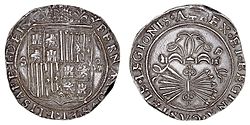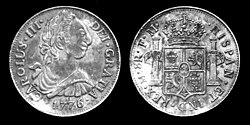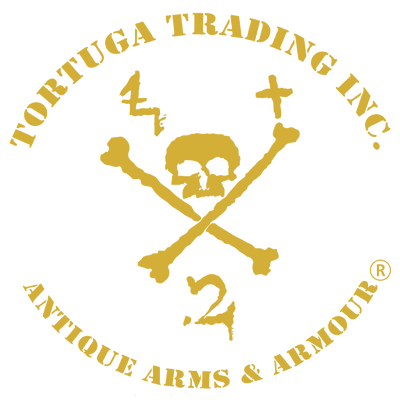Pirate Treasure ! Spanish Old World 4 Reales COB Set In 14K Gold
Pirate Treasure !
An Antique Spanish Old World 4 Reales COB, "PIECE OF EIGHT" Coin. Set In 14K Gold with a nautical shackle so the coin can be worn as a pendant.
MINT: "S" Seville, Spain
ASSAYER: "V"
DATE: nv., circa. 1612-1616
REIGN: PHILIP III
WEIGHT: 12.63 grams.
GOLD WEIGHT: 5.37 grams of 14K gold.
PROVENANCE: Unfortunately lost to time.
Note: The coin exhibits evidence of being recovered from the ocean (most likely from a shipwreck) especially on the shield side where there is still green saltwater corrosion visible.
Additional Notes: These coins were the most desirable currency of the world for over 300 years from the 1500's - 19th century and were legal tender in the United States until the Act of 1857.
TTI-549321
Some History About The Spanish Coins.
Cob coins were minted at many Spanish Main Land and Spanish colonial New World mints. They were hand manufactured by cutting blanks from crudely cast bars of refined silver or gold and hand hammered between crudely engraved dies. Each is unique in shape and strike.
During the 16th, 17th, and 18th centuries, Spain became the premier supplier of gold and silver coins for the world. This was accomplished through the discovery of untold riches that were effectively mined in the Americas. Although Spain's mighty armada strove diligently to deliver wealth to the King, both pirates and bad weather became such obstacles that many galleons were lost at sea. Today's technology enables us to explore the ocean floor for its spectacular treasure.
Coinage of this historical period has fascinated experts as well as novices. These pieces were struck from dies and cut to weight according to the Spanish monetary system. They were called "macuquinas" in Spanish but are known to us as "cobs". Minted in five denominations in silver, the largest was the Eight Reales, famous in the colonies and among pirates as a "Piece Of Eight". The other denominations were Four Reales, Two Reales, One Reale and Half Reale.
SPANISH DOLLAR
|
||||||
|
||||||
|
||||||
|
||||||
|
||||||
|
||||||
The Spanish dollar, also known as the piece of eight (in Spanish: Real de a ocho, Dólar, Peso duro, Peso fuerte or Peso), is a silver coin of approximately 38 mm (1.5 in) diameter worth eight Spanish reales. It was minted in the Spanish Empire following a monetary reform in 1497. It was widely used as the first international currency because of its uniformity in standard and milling characteristics. Some countries countersigned the Spanish dollar so it could be used as their local currency.[1]
The Spanish dollar was the coin upon which the original United States dollar was based, and it remained legal tender in the United States until the Coinage Act of 1857. Because it was widely used in Europe, the Americas, and the Far East, it became the first world currency by the late 18th century.[2][3][4] Aside from the U.S. dollar, several other currencies, such as the Canadian dollar, the Japanese yen, the Chinese yuan, the Philippine peso, and several currencies in the rest of the Americas, were initially based on the Spanish dollar and other 8-real coins.[5] Diverse theories link the origin of the "$" symbol to the columns and stripes that appear on one side of the Spanish dollar.[6]
The term peso was used in Spanish to refer to this denomination, and it became the basis for many of the currencies in the former Spanish colonies, including the Argentine, Bolivian, Chilean, Colombian, Costa Rican, Cuban, Dominican, Ecuadorian, Guatemalan, Honduran, Mexican, Nicaraguan, Paraguayan, Philippine, Puerto Rican, Peruvian, Salvadoran, Uruguayan, and Venezuelan pesos. Of these, "peso" remains the name of the official currency in Argentina, Chile, Colombia, Cuba, Dominican Republic, Mexico, Philippines, and Uruguay.
Millions of Spanish dollars were minted over the course of several centuries. They were among the most widely circulating coins of the colonial period in the Americas, and were still in use in North America and in South-East.


















